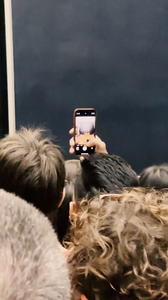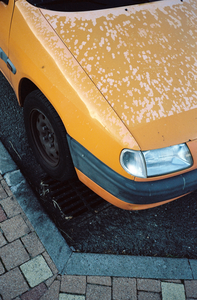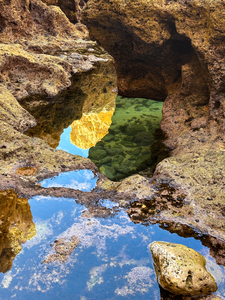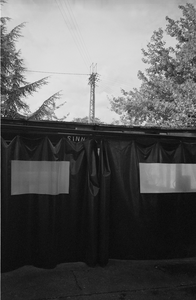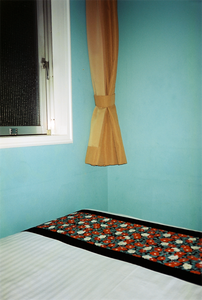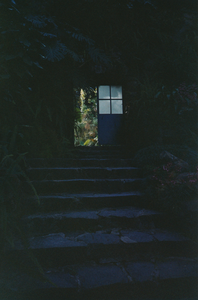Arbeiten
Series of 12 analog photographs (as leporello), sound (27:30 min.)
We Build What You Dream is a slogan frequently encountered in Thailand in the context of massive construction projects. Printed on large-scale banners, often attached to imposing bamboo scaffolding, it can also be interpreted as a reflection of a country caught in the perpetual tension between tradition and modernity.
This ambivalence is also reflected in the present work, which consists of a leporello with twelve analog photographs and a sound piece comprising six tracks.
The compositions are based on field recordings, primarily captured in the rural regions of northern Thailand and the jungle of Ko Phayam island. Additional recordings were made in the vibrant capital, Bangkok, where electromagnetic radiation from overhead power lines and various electronic devices was made audible. The resulting sounds at times evoke a dystopian atmosphere, directly contrasting with the harmonic tones of nature. These recordings are complemented by altered tape loops sourced from old Thai cassettes from the 1980s, artistically bridging the gap between traditional, partly folkloric music and new, contemporary soundscapes.
Dialogue, 2024
HD film, colour (6:15 min.)
Psychological studies suggest that the act of photographing or filming can impair memory retention. Henkel (2014) refers to this as the Photo-Taking Impairment Effect—the tendency to remember fewer details of an event when it is captured through a camera. This phenomenon is also observable in the context of museum visits, where viewers who experience art primarily through the lens of their smartphones may become less deeply engaged with the artwork’s content, structure, and artistic intent. In this context, the act of quickly capturing an image for later use often takes precedence over conscious, present-moment perception.
The video work Dialogue addresses these issues by deliberately adopting a smartphone format (9:16), which has become the standard for contemporary social media. The film presents museum visitors in front of the Mona Lisa in the Louvre, who, rather than engaging directly with the painting, observe it predominantly through their smartphone screens. The use of slow-motion amplifies the absurdity of the situation, as visitors’ movements become exaggerated, while the iconic artwork itself recedes into the background. The accompanying sound work further emphasizes the sense of alienation between the viewer and the artwork, enhancing the disconnection that results from this mediated interaction.
References
Henkel, L. A. (2014). Point-and-Shoot Memories: The Influence of Taking Photos on Memory for a Museum Tour. Psychological Science, 25(2), 396–402.
Series of 33 analog photographs, colour
The work Kalte Progression serves as an artistic commentary on the political and societal shifts within the Western world, which have become increasingly evident in recent years. The 33 analog photographs reveal subtle, often barely noticeable changes that metaphorically address the fragility of democratic structures and the once-assumed security now called into question.
The title, derived from the German tax system, alludes to the invisible effects of inflation and tax policies—drawing attention to gradual processes that may lead to profound societal transformations.
Margarete, 2017
"In 2017, my grandmother passed away following a brief and intense illness. As a tribute to her and my childhood, I walked through her house for the last time on the day of her funeral. I photographed moments and objects that had left a lasting impression on me as a child. In a sense a part of my childhood died with her."
148 mm x 210 mm
zine, 24 pages
edition of 50 (signed and numbered)
self-published in 2019
Happy World, ongoing since 2016
In the eyeball, there is an area without photoreceptors, known as the "blind spot," located where the optic nerve connects to the brain. Since we usually have two eyes and the distance between our eyes and the objects we look at, as well as the angle of vision, constantly changes, the "blind spot" only peripherally affects our vision.
However, the "blind spot" can also be metaphorically compared to our perception of the world. There are things, phenomena, and processes that only some of us are able to recognize and understand. It is said that our world is not the only one, but that it divides, like a living organism, into cells containing millions upon millions of small worlds. Each person lives in their own unique world and perceives things differently from how we do. Our own world is difficult to explain, as it is so different from what other people know, and how can we grant others insight into this world if not through the lens of a camera?
“Doors are holes in walls for entering and exiting. One goes out to experience the world and gets lost within it, and one returns home to find oneself again, losing in the process the world that one sought to conquer.” (1)
In Happy World, Jakob Sinn takes the viewer on a journey through his own visual worlds, showing details that we would fleetingly overlook in passing, and invites us to pause for a moment to look behind the scenes. His minimalist images are marked by a melancholic stillness. He focuses on things that initially seem banal but begin to come together as a whole when you look at them for longer.
— (1) Vilém Flusser »Durchlöchert wie ein Emmentaler - Über die Zukunft des Hauses«, 4.3.1998, Telepolis (Stand 4/2007)
Text by Rosa Roth
Published by Textem Verlag, Hamburg
"A state of melancholy, loneliness, and profound longing, the Portuguese term Saudade resists a simple, straightforward definition. In 2016, Hamburg-based artist Jakob Sinn embarked on a personal exploration of this complex emotion in Lisbon. The resulting work, a small and intimate book, offers a journey into the essence of Saudade, not through a literal explanation, but through an evocative portrayal that allows the reader to experience its emotional depth."
140 mm x 210 mm
clothbound book
56 pages
edition of 500 (signed and numbered)
ISBN: 978-3-86485-178-0
https://jakobsinn.bigcartel.com/product/saudade








